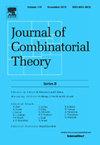图的度截断选择能力
IF 1.2
1区 数学
Q1 MATHEMATICS
引用次数: 0
摘要
图G称为度截断k-可选,如果对于每一个列表赋值L,当|L(v)|≥min (dG(v),k)时,对于每个顶点v, G是L-可着色的。Richter问是否每一个3连通的非完全平面图都是度截断6可选的。通过构造一个不截断7度的3连通非完全平面图,否定地回答了这个问题。然后我们证明了每一个3连通的非完全平面图都是截断度的16- dp可着色的(因此截断度的16- dp是可选择的)。我们进一步证明,对于任意一个图的固有小闭科G,设s为最小整数,使得k,t∈G对于某t,则存在一个常数k,使得除GDP树以外的每一个s连通图G∈G都是截断度的dp -k可着色的(因此是截断度的k可选择的),其中GDP树是其块为完全图或环的图。特别地,对于任意曲面Σ,存在一个常数k,使得每个可嵌入Σ上的3连通非完全图都是度截断的dp -k可着色的(因此度截断的k是可选择的)。G中的图的s连通性(以及可嵌入到Σ上的图的3连通性)是必要的,因为对于任何正整数k, Ks−1,Ks−1∈G (K2, K2是平面的)不是度截断的k可选的。此外,非完备性是一个必要条件,因为完全图是不可度选择的。本文章由计算机程序翻译,如有差异,请以英文原文为准。
Degree-truncated choosability of graphs
A graph G is called degree-truncated k-choosable if for every list assignment L with for each vertex v, G is L-colourable. Richter asked whether every 3-connected non-complete planar graph is degree-truncated 6-choosable. We answer this question in negative by constructing a 3-connected non-complete planar graph which is not degree-truncated 7-choosable. Then we prove that every 3-connected non-complete planar graph is degree-truncated 16-DP-colourable (and hence degree-truncated 16-choosable). We further prove that for an arbitrary proper minor closed family of graphs, let s be the minimum integer such that for some t, then there is a constant k such that every s-connected graph other than a GDP tree is degree-truncated DP-k-colourable (and hence degree-truncated k-choosable), where a GDP-tree is a graph whose blocks are complete graphs or cycles. In particular, for any surface Σ, there is a constant k such that every 3-connected non-complete graph embeddable on Σ is degree-truncated DP-k-colourable (and hence degree-truncated k-choosable). The s-connectedness for graphs in (and 3-connectedness for graphs embeddable on Σ) is necessary, as for any positive integer k, ( is planar) is not degree-truncated k-choosable. Also, non-completeness is a necessary condition, as complete graphs are not degree-choosable.
求助全文
通过发布文献求助,成功后即可免费获取论文全文。
去求助
来源期刊
CiteScore
2.70
自引率
14.30%
发文量
99
审稿时长
6-12 weeks
期刊介绍:
The Journal of Combinatorial Theory publishes original mathematical research dealing with theoretical and physical aspects of the study of finite and discrete structures in all branches of science. Series B is concerned primarily with graph theory and matroid theory and is a valuable tool for mathematicians and computer scientists.

 求助内容:
求助内容: 应助结果提醒方式:
应助结果提醒方式:


